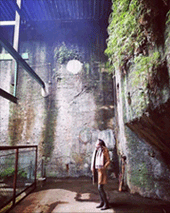
On the southernmost end of Fukuoka prefecture, bordered by the Ariake sea in the west and Miike mountain in the Northeast, lies the city of Omuta (大牟田市).Though the area is far from expanse, there is much to see and do and plenty of reasons to visit!

(Photo of by @ n.chuusan0914)
The Daijyayama Festival is Omuta’s signature summer event.
It’s held on the fourth Saturday and Sunday of July and has over 30,000 attendees each year!

The origins of the Festival are believed to be over 350 years old, when the Daijayama character was born.
Legend has it that the water gods of the Suijin Faith (symbolized by snakes and dragons) and the gods of the Gion Faith (agriculture and cleansing) were intertwined, thus creating the legendary Daijayama.
During the festival, people parade through the city riding on the large serpent Daijayama floats, while playing taiko drums and ringing bells.
The floats are over 10 metres long, weigh around 3 tons, and have handmade heads, torsos and tails created out of paper and bamboo.
The Daijayama are brought to life by the work of over 200 people, who help the creatures move their heads, widen their eyes, and breathe fire and smoke (thanks to hand-held fireworks) from their gaping mouths.
(photo by: @mie.38_k)

Other festival highlights include fireworks, Port Festival, and the Grand Dance, where over 10,000 people dance in procession for 2km to the Daijayama and Tankobushi songs.
This is surely an event not to miss!
(Photo of by @ n.chuusan0914)

Renowned hot springs like Mikawa Onsen, Hirayama Onsen and Yamaga Onsen are not too far away and are sure to ease your tired muscles after a long day’s travel.
History buffs should be sure to visit Sakura Onsen, built 370 years ago. The wooden building was initially only used by domain officials, but is open to the public these days.
Today, its Edo period architectural design is still preserved.
(photo of Hirayama Onsen by @djosamum)
Japan is famous for cherry blossoms in the spring, but there are so many other beautiful flowers to see.
The Omuta area has a delightful range of flora you can gaze upon through the seasons!





Though the city is far from expanse, Omuta is full of fine food!



You can begin your world cultural heritage tour at the Omuta Coal Industry and Science Museum.
There you can learn about the Sites of Japan’s Meiji Industrial Revolution: Iron and Steel, Shipbuilding, and Coal Mining, which symbolize Japan’s rapid modern industrialization.
The World Heritage sites you should certainly not miss are the Miyanohara Pit, the Miike Coal Railway, the Manda Pit and the Miike Port.
(photo by: @hideki_tsukahara)

Beautiful red-brick Meiji industrial buildings, juxtaposed with metallic machinery are the focal points of both Miyanohara and Manda Pits. Both locales house original machinery, and feature steal head framed shafts (pictured above).
In the early 1900's, Miyanhara Pit boasted the most up-to-date and powerful pumping facilities in the world.

Coal production and distribution transformed the rural Japanese landscape into a modern one, but a mass-distribution system of coal needed railways and electricity.
Miike Coal Railway linked pit to port, and helped facilitate quick, constant movement of bulk amounts of coal. (photo by @kyushu.ambassador)

Like Miyanohara, Manda Pit's red brick buildings are a beautiful stand out feature. In 1910, Manda Pit boasted the technical culmination of imported British steam-pumping, winding, and ventilation machinery.
(photo by @kumamoto_to_the_world)

Miike Port was built as a modern electrified coal export for the Mine.
Its, "hummingbird" design incorporated a long jetty to keep the channel free of sediment from the shallow Ariake Sea.
It featured a large outer harbour and inner basin, with hydraulic lock gates that maintained the water level for the large ships, helping them to be mechanically loaded no matter the tide.
(photo by @omutaboy1961 )
With so much to see and do in Omuta, it’s certainly a city you don’t want to miss!
